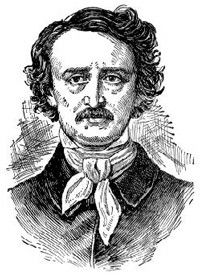
Edgar Allan Poe (1809-1849) was an American writer, celebrated for his dark, gothic tales of horror and suspense. He enjoyed playing games of rationality with his readers. Sometimes he cast himself as a master detective capable of discerning the truth behind any illusion or riddle, a role he expressed through the famous character of Chevalier C. Auguste Dupin. This is also seen in his effort to solve puzzles, such as the mystery of the operation of the
Great Chess Automaton.
At other times, Poe liked to display his ability to hide the truth from his readers, to force them to play detective. He published six hoaxes during his brief life. Most modern anthologies of his works fail to note that these stories were first presented to readers in the guise of nonfiction. In fact, both detective and hoaxer were two sides of the same coin for Poe. Both roles manifested the power he believed a rational mind could wield over reality. Poe was also fascinated by other hoaxes besides his own. He once referred approvingly to the age in which he lived as the "epoch of the hoax."
Listed below are his six hoaxes.

 Edgar Allan Poe (1809-1849) was an American writer, celebrated for his dark, gothic tales of horror and suspense. He enjoyed playing games of rationality with his readers. Sometimes he cast himself as a master detective capable of discerning the truth behind any illusion or riddle, a role he expressed through the famous character of Chevalier C. Auguste Dupin. This is also seen in his effort to solve puzzles, such as the mystery of the operation of the Great Chess Automaton.
Edgar Allan Poe (1809-1849) was an American writer, celebrated for his dark, gothic tales of horror and suspense. He enjoyed playing games of rationality with his readers. Sometimes he cast himself as a master detective capable of discerning the truth behind any illusion or riddle, a role he expressed through the famous character of Chevalier C. Auguste Dupin. This is also seen in his effort to solve puzzles, such as the mystery of the operation of the Great Chess Automaton.
Comments